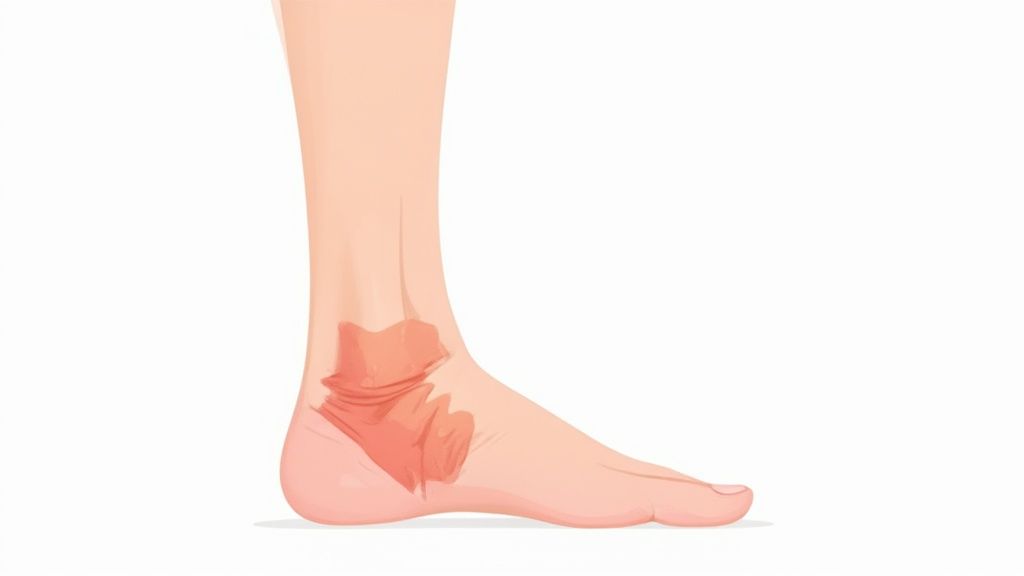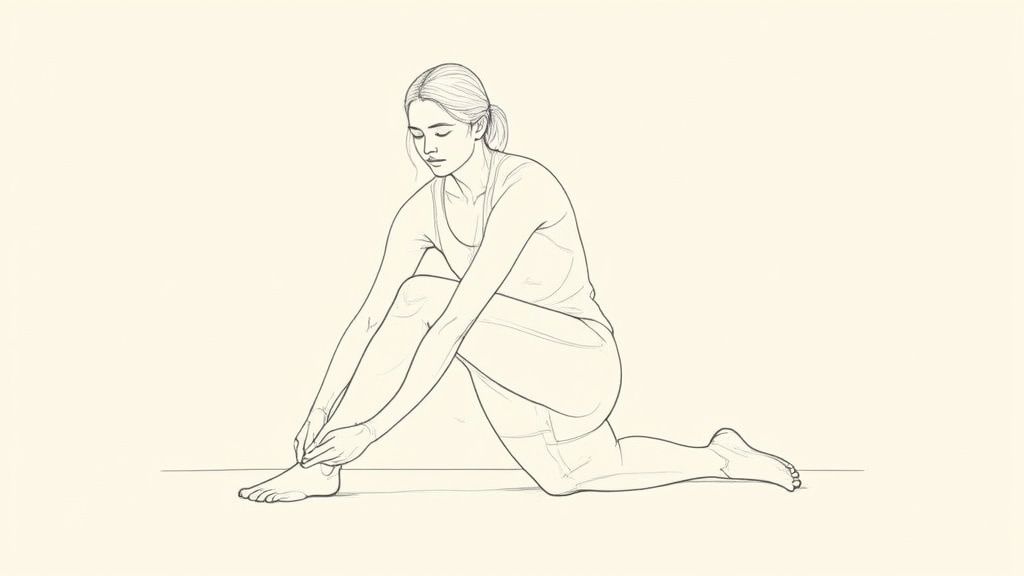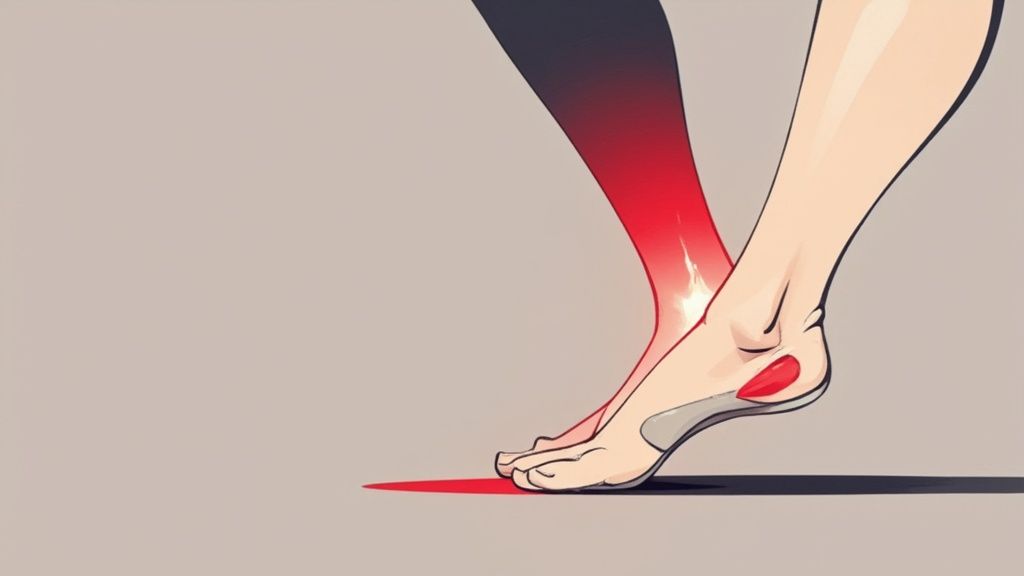Your Foot's Pain Map: Understanding Where Plantar Fasciitis Pain Is

Imagine your foot as a finely tuned instrument. The plantar fascia, a thick band of tissue, acts like a taut string running from your heel to your toes. When this "string" gets irritated, the resulting plantar fasciitis pain isn't random. It follows specific patterns, almost like predictable notes on a musical scale. Understanding these patterns helps us diagnose and treat the issue effectively.
One of the most common areas affected is the heel. Think of it as the anchor point of the plantar fascia. This makes it especially vulnerable to strain. This explains why many people experience the sharpest pain in their heels, especially with those first steps in the morning.
For some, it feels like stepping on broken glass. For others, it's a dull, throbbing ache. This localized pain is a key characteristic of plantar fasciitis. Interestingly, plantar fasciitis affects about 10% of the general population, with 83% of cases occurring in working adults aged 25-65. The pain is primarily in the heel because that's where the plantar fascia attaches to the heel bone. Discover more insights about plantar fasciitis prevalence.
But the pain doesn't always stay put in the heel. As the condition progresses, you might feel tension or a burning sensation radiating along the arch of your foot. This is because the plantar fascia also supports your arch, and inflammation can travel along its length.
In addition, some people experience what's called referred pain in their toes, ankles, or even calves. This happens because people often change how they walk to avoid heel pain, which can then strain other muscles and joints. Understanding these connected pain points gives us a more complete understanding of how plantar fasciitis affects the whole foot and leg.
The Classic Heel Pain: When Your Morning Turns Painful

That sharp, stabbing sensation in your heel as you take those first steps out of bed? That's the telltale sign of plantar fasciitis pain. It typically centers on the inside edge of your heel, right where the plantar fascia connects to the heel bone. Imagine the plantar fascia as a bowstring: after a night of rest, it's suddenly pulled taut, causing that initial burst of pain.
But not everyone experiences this pain the same way. Some describe it as walking on broken glass—a sharp, intense feeling. Others feel a deep, dull ache that worsens throughout the day. This variation depends on how inflamed the fascia is and each individual's pain tolerance. The key is the location: that distinctive heel pain, especially prominent in the mornings, is a strong indicator of plantar fasciitis.
Why the Heel?
This specific attachment point is especially vulnerable because it bears the brunt of your body weight with each step. Think of it as the foundation of a house: a weak foundation compromises the entire structure. As plantar fasciitis progresses, the pain can also change. What starts as a morning annoyance can become a nagging ache that limits your daily activities.
To help differentiate plantar fasciitis from other conditions that cause heel pain, take a look at the comparison table below:
Heel Pain Characteristics: Plantar Fasciitis vs Other Conditions
| Condition | Pain Location | Pain Timing | Pain Description | Common Triggers |
|---|---|---|---|---|
| Plantar Fasciitis | Inside edge of heel | Worse in the morning or after rest; improves with activity, but may worsen with prolonged standing or activity | Sharp, stabbing, or dull ache | Prolonged standing, high-impact activities, improper footwear |
| Heel Spur | Bottom of the heel | Often worse in the morning | Sharp, shooting pain | Similar to plantar fasciitis |
| Achilles Tendonitis | Back of the heel | Worse with activity | Aching, stiffness, sometimes burning | Overuse, tight calf muscles, improper footwear |
| Bursitis | Back of the heel | Worse with activity or pressure | Pain, swelling, redness | Repetitive rubbing or pressure on the heel |
| Stress Fracture | Anywhere in the heel | Worse with weight-bearing | Deep, dull ache, pinpoint tenderness | Repetitive high-impact activities |
As you can see, while several conditions can cause heel pain, the specific location, timing, and characteristics can help pinpoint the cause.
For more practical advice on managing heel pain, check out this helpful resource: Heel Pain: Top Tips for Finding Relief. Understanding the specific characteristics of plantar fasciitis heel pain—its location, intensity, and how it changes—is crucial for effective treatment. By learning to recognize these signs, you'll be better equipped to manage your plantar fasciitis and seek appropriate care.
The Arch Tension: When Support Becomes The Problem

We’ve talked about heel pain, but let’s shift our focus slightly to another common trouble spot in plantar fasciitis: the arch of your foot. Think of your arch like a spring, designed to absorb the impact of each step you take. It's a crucial support system. However, when plantar fasciitis strikes, this normally helpful structure can become a real source of discomfort, feeling less like a spring and more like a tightly pulled rubber band.
This arch pain often presents differently than the sharp, stabbing heel pain many people experience. It’s typically described as a deep, dull ache that can spread across the entire arch, sometimes radiating from the inner edge all the way to the outer edge of your foot. Interestingly, for some, the arch tension is even more noticeable than the heel pain, a difference often influenced by individual factors like foot structure, how active they are, and even their walking style.
Why the Arch Gets Involved
The plantar fascia, that pesky band of tissue we've been discussing, doesn't just attach to your heel. It actually runs along the entire bottom of your foot, providing essential support to the arch. So, when the plantar fascia becomes inflamed, that inflammation can travel, leading to tension and pain throughout the arch. This interconnectedness is why understanding the arch’s role in plantar fasciitis is so vital for a solid recovery plan. For those curious about how foot structure plays a role, you might find this article on flat feet symptoms, causes, and relief insightful.
Speaking of support, it's worth mentioning that proper support in other areas of your life can also influence pain. For example, if you're experiencing heel pain, something as seemingly unrelated as your office chair can make a difference. A good resource for finding the best office chair for back pain might be helpful. Whether it's your shoes or your workspace, proper support can significantly affect how your body handles pain and stress.
The Surprising Pain Travelers: Beyond Your Foot

Here's a surprising fact about plantar fasciitis pain: it often doesn't stay put in your foot. Think of it like a pebble dropped in a pond. The initial splash is the pain in your heel, but the ripples spread outwards, affecting other areas. Plantar fasciitis can trigger a chain reaction throughout your body.
If you’ve ever sprained an ankle, you know how it changes the way you walk. You might limp, favoring the other leg. That limp, a natural response, puts extra stress on your knee, hip, and even your lower back.
Similarly, plantar fasciitis pain causes you to subconsciously adjust your gait to avoid heel pressure. This altered way of walking can have ripple effects throughout your body. That stiffness in your ankle? The tight calf muscles? That nagging knee pain? They could all be connected to how you've compensated for your plantar fasciitis.
Beyond the Immediate Area
This "pain migration" isn't random. It's your body’s intelligent, albeit sometimes problematic, way of adapting. These adaptations, while meant to protect you, can create new issues. For instance, someone with plantar fasciitis might roll their foot inward when walking (overpronation) to lessen heel pressure.
While overpronation might temporarily relieve heel pain, it can strain the ankle and tighten the calf muscles. This shift in how you walk can also affect the alignment of your knees and hips, potentially leading to pain in those areas too.
Additionally, some people even experience lower back pain due to posture and gait changes caused by plantar fasciitis. This domino effect underscores the importance of addressing plantar fasciitis early. You might be interested in learning about Achilles tendinopathy, a related condition often influenced by similar biomechanical factors. Recognizing these interconnected pain patterns is crucial for effective treatment and preventing long-term problems. By understanding how plantar fasciitis pain can extend beyond the foot, we can take a more holistic approach to treatment and long-term foot health.
Pain's Daily Dance: How Location Shifts Hour By Hour
If you have plantar fasciitis, you know its pain isn't constant. It changes throughout the day. Mornings might greet you with a sharp, stabbing pain in your heel—that dreaded "first-step" pain. Come afternoon, the discomfort might shift to a tense arch. And by evening, your whole foot could feel like it’s been through a marathon. This shifting pain isn't random; plantar fasciitis pain often follows predictable patterns.
Your daily activities, the surfaces you walk on, the shoes you wear, and even things like the weather and your stress levels can all influence your pain. Imagine walking barefoot on a hard floor all day compared to wearing supportive shoes on a softer surface. The difference in impact and strain on your plantar fascia is huge.
Understanding Your Pain Timeline
Let’s walk through a typical day for someone dealing with plantar fasciitis. That sharp morning heel pain? It happens because the plantar fascia tightens overnight. When you start moving, it stretches, causing that initial burst of pain.
As you get moving and become more active, the pain might decrease but could shift to your arch as it absorbs the impact of your steps. Pain radiating beyond the foot itself can sometimes be addressed with therapies like massage. For example, a sports massage for runners could offer some relief.
Later in the day, especially after you’ve been standing or active for a while, both heel and arch pain can intensify. This happens because the plantar fascia becomes overworked and inflamed. Think of it like a rubber band stretched too far – it loses its elasticity and starts to hurt.
To help visualize this, let’s look at a typical pain pattern:
To help you visualize this further, here’s a table illustrating a typical 24-hour pain cycle in plantar fasciitis.
Daily Pain Pattern Timeline: A comprehensive breakdown of how plantar fasciitis pain typically changes in location and intensity throughout a 24-hour period.
| Time of Day | Primary Pain Location | Pain Intensity | Common Triggers | Relief Strategies |
|---|---|---|---|---|
| Early Morning | Heel | Severe | First steps out of bed | Gentle stretching, rolling foot on a frozen water bottle |
| Mid-Morning | Heel/Arch | Moderate | Prolonged standing, walking on hard surfaces | Supportive footwear, arch supports |
| Afternoon | Arch | Mild to Moderate | Increased activity | Rest, elevating feet |
| Evening | Heel/Arch | Moderate to Severe | After prolonged activity, standing | Rest, ice, stretching, pain relievers |
| Night | Heel | Mild to Moderate | Inactivity, pointing toes | Night splints, stretching before bed |
As you can see, the pain intensity and location fluctuate throughout the day, often correlating with specific activities.
Understanding your personal pain timeline is like having a secret weapon. It helps you anticipate when pain might strike, allowing you to plan your activities and incorporate strategies to manage the discomfort. It also provides your doctor or physical therapist with valuable information for creating a treatment plan tailored to your specific needs.
Your Job's Role: How Work Shapes Your Pain Experience
Think about how different jobs demand different things from our bodies. Imagine a nurse, constantly on their feet, hurrying between patients. Their experience with plantar fasciitis pain will be very different from a teacher, who might stand for long periods at the front of a classroom. And both will differ from a retail worker, pacing back and forth on hard concrete floors all day. Each work environment creates unique challenges for the plantar fascia.
It's not just about how much activity you do, but also the type of activity. Construction workers, navigating uneven terrain, may experience more arch pain because their feet are constantly adjusting to maintain balance. On the other hand, office workers who suddenly increase their activity, maybe by starting a new running routine, often experience that classic plantar fasciitis pain focused in the heel due to the sudden strain.
Certain jobs just come with higher risks. Plantar fasciitis isn't just a personal discomfort; it's a significant occupational hazard, especially in professions requiring prolonged standing or walking. A study of nurses in government tertiary care hospitals, for example, highlighted the prevalence and risk factors of plantar fasciitis in this profession. Discover more insights on plantar fasciitis and occupational health.
Understanding how your job affects your plantar fasciitis is key. It's not simply about comfort; it's about protecting your ability to work and earn a living long-term. By recognizing these occupational influences, you can make informed decisions about managing your current symptoms and preventing future flare-ups. This might mean adapting your work habits, getting supportive footwear, or pursuing specific therapies to address the particular stresses your job puts on your feet.
The Hidden Costs: What Foot Pain Really Takes From You
Let's have a frank conversation about something we often overlook: the true cost of plantar fasciitis. It's not just about the throbbing ache in your heel; it's the domino effect it has on your life, your finances, and even your future.
Think about it: specialized footwear, custom orthotics, appointments with specialists, physical therapy sessions, and the ongoing need for pain relief. These expenses accumulate quickly. In fact, plantar fasciitis places a substantial financial burden on the United States, costing an estimated $284 million annually. A significant 28% of individuals dealing with this condition spend upwards of $250 each month just on managing their pain. Discover more about the financial impact of plantar fasciitis. This represents a substantial hidden cost often not considered.
But the financial strain is only the beginning. Plantar fasciitis can significantly impact your productivity. Imagine struggling to get out of bed each morning, the pain affecting your ability to focus at work or complete daily tasks. Think about missing social gatherings, a friend's wedding, or a family hike, simply because walking is too agonizing. Understanding the impact of your work environment on your body is key. Learn more about how poor ergonomics affects different body parts here. These are real sacrifices that diminish your overall quality of life.
Finally, let's consider the long-term consequences. You might shy away from career opportunities that require prolonged standing or walking, limiting your professional advancement. The pain could discourage you from staying active, potentially leading to other health issues down the road. Untreated, plantar fasciitis can steal more than just your comfort; it can impact your future mobility, your financial security, and your overall well-being.
Addressing plantar fasciitis isn't just about finding relief today; it's an investment in your future. If you're ready to take control of your foot pain and prioritize your long-term health, explore the range of supportive insoles specifically designed for plantar fasciitis available at Samurai Insoles.



